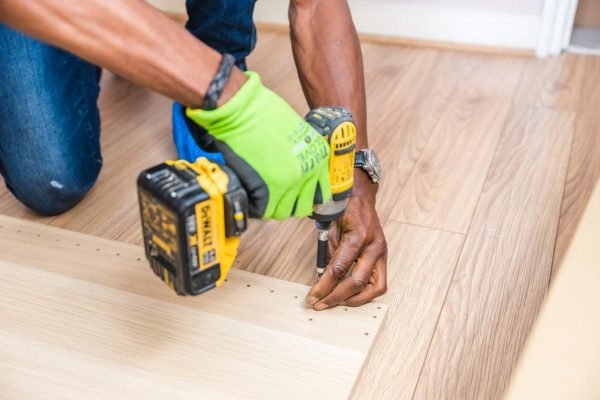
In today’s market, it’s more important than ever to make sure you’re doing everything you can to increase the value of your home. Even if you’re not planning on selling shortly, it’s worth investing in some creative remodeling projects that will help your house stand out from the pack. Remodeling a home can be a great way to increase its value, but you need to ensure that the changes you make don’t end up making it less valuable. There are many creative ways to remodel your home to make it more appealing, but also keep it in line with what potential buyers are looking for. The following article will discuss some creative ideas for increasing your home’s value without lowering its saleability.
Replace Your Front Door
If you’re looking to increase the value of your home, consider replacing your front door with a more energy efficient one. New doors can be made with high-quality insulation, which will help keep your home cooler in summer and warmer in winter.
Another way to increase the value of your home is by installing a security door that is heavy-duty and more difficult for intruders to break through than a traditional wooden frame door. This could mean spending more money upfront but it will pay off over time as burglars won’t be able to get into your house so easily–and therefore won’t target it as often! Finally, consider replacing every door in your house (or at least all those leading from inside) with stylish glass panels instead of solid wood or metal ones; this can add style while also providing natural light into otherwise dark areas such as basements or closets.”
Add deco panels
If you’re looking for creative remodeling ideas to increase your home’s value, then consider adding deco panels like this, deco panel in Brisbane. These panels will make any room more visually interesting, and they can also be used to add dimensional depth to a space. They can be used on the ceiling or the walls, and they come in a variety of colors and finishes.
Deco panels are especially popular because they can help to break up large expanses of color, which can make rooms feel smaller and more claustrophobic. The addition of deco panels along with other decorative elements such as artwork and mirrors will also help to make your room appear more luxurious.
Install New Flooring
You can update your home’s style with stylish flooring. There are many types of flooring available, but each has its advantages and disadvantages.
There are two main types of flooring: hardwood and carpeting. Hardwood floors are made from real wood planks that have been glued together and sanded smooth; they tend to be very durable and add warmth and character to any room in which they’re installed. Carpeting comes in many different varieties–from low-pile rugs that feel soft underfoot but don’t provide much traction, up to high-density wall-to-wall carpets with deep pile (which provides more comfort). Carpet is usually cheaper than hardwood but requires more maintenance over time because it can get dirty easily; furthermore, some people find it difficult on their knees when kneeling on them (such as during prayer).
Restore old frames
Restoring old frames is a great way to give your home an updated look without breaking the bank. If you’ve got some old photographs and paintings sitting around, consider having them framed. You can restore old frames by removing the glass and backing of the frame, sanding down any rough edges or splinters, cleaning them thoroughly with a soft cloth or sponge dipped in warm water and soap (use dish soap if necessary), then repainting with spray paint made specifically for wood surfaces (such as Kilz). Once dry, reattach both pieces of glass back onto their original positions using painter’s tape on each side so they stay firmly in place while drying overnight before hanging up your newly restored masterpiece.
Frame restoration is one of our favorite ways to add value without breaking the bank. By repairing and repainting your home’s exterior, you can give it a fresh new look that will increase its value in no time—without having to invest any money into construction or renovation. Frame restoration is a quick and easy way to make your home look brand new again, so even if you’re on a tight budget, this is an option worth considering!
Update Your Lighting
Lighting is another area where you can make quick, inexpensive changes that will have a big impact on your home’s value. The first thing you should do is replace any old light bulbs with energy-efficient ones. Then, consider installing dimmer switches so that you can adjust the brightness of lights in different rooms as needed. Next up: take a look at what kind of lighting fixtures are currently installed throughout your house and think about whether or not they match the decor of each room (and whether or not they fit with the style).
If none of these options work for you, consider changing up your color scheme instead. Changing out an orange bulb for a red one might be enough to give an outdated kitchen an updated look–and it won’t cost much either! Finally, if none of these ideas sound appealing then go ahead and invest in some new track lighting or recessed lighting systems which give off more focused illumination than traditional overhead fixtures do.”
Replace with new roofing
Replacing your roof is a major investment, but it can also be one of the most rewarding. It’s not just an aesthetic decision–replacing your roof with new materials will increase the value of your home and make it more energy efficient. Newer roofs are better at keeping out moisture and preventing leaks, so they’ll last longer than older ones. And if you choose high-quality materials that last longer than expected, then you’ll save money in the long run on repairs as well as maintenance costs like cleaning shingles or replacing gutters every few years (which would otherwise wear out before their time).
With a good roofer like this Brisbane roofers, you can count on quality workmanship and a lasting solution to any problems with your roof. But there are other things you can do to increase the value of your home as well, including changing out your windows, adding a porch or fence, or even landscaping around the house. Any of these projects can help you sell your home more quickly and for more money when the time comes.
Replace Your Garbage Disposal
One of the easiest ways to increase the value of your home is by replacing your garbage disposal. If you notice that your garbage disposal has been on the fritz lately and doesn’t seem to be working as well as it used to, then this might be an indication that it needs to be replaced with a new one. You should also check underneath your sink for any signs of leaks or clogs from other plumbing fixtures before calling a plumber; often these issues are what cause problems with garbage disposals in the first place.
Remodel your bathrooms
Remodeling your bathrooms is a great way to increase the value of your home. Bathrooms are one of the most common places to see renovation projects, as they can be updated at a relatively low cost. New fixtures, like new sinks or toilets, can make your bathroom look brand new and modern. Tile flooring can also make it seem like there’s more space in the room than before–and with brighter lighting, it’ll feel even more spacious.
Bathroom renovation like this, bathroom renovations in North Shore Auckland is a great way to add value to your home. It’s also a great way to increase the functionality of your bathroom, improve the aesthetics of your home, and make it more comfortable for you and your family. When you’re updating your bathroom, it’s easy to get caught up in the idea of what you want and forget about what other people will think of it.
Upgrade Your Kitchen Sink
The kitchen sink is arguably the most important part of your kitchen. It’s where you wash dishes, hands, and even sometimes food. If you’re looking to update your sink but don’t want to spend a lot of money on it–and who does?–some simple things can be done to make it look brand new again.
First off, if there is any rust around the base of your current sink or on any other parts of its structure (such as faucets), get rid of it by scrubbing it with steel wool or sandpaper until all traces are gone. This will ensure that no more rust forms in those places again! Next up: replacing anything that doesn’t work quite right with something new and improved. Consider replacing both drain assemblies if one has become clogged over time; this will save time when cleaning out drains later down the line because they won’t fill up as quickly due to being blocked by debris such as hairballs from pets’ grooming sessions). You could also replace garbage disposal units since they wear out after many years’ worth of usage so having brand new ones installed could help improve efficiency levels dramatically.”
Replace Your Countertops
Replacing your countertops is a great way to add value to your home. However, replacing countertops can be expensive and there are many different materials from which you can choose. Some of these materials are more durable than others, so it’s important to choose one that will last for the lifetime of your home.
If you are replacing your existing countertops with new ones, then it’s likely that you will also need to replace the sink as well (unless it’s an island sink). This means that if you’re planning on doing any kind of remodeling project like this one–or any other type of remodeling project–you should hire professionals who have experience working with contractors and subcontractors to ensure everything goes smoothly.
Replace Your Appliances
One of the best ways to increase the value of your home is by replacing your appliances. While it may seem like an expensive undertaking, upgrading your appliances can actually save you money in the long run. When buying new models, it’s important to look for Energy Star-labeled products since they tend to be more efficient than other models and use less energy.
When considering kitchen remodeling ideas, think about what kind of new equipment would fit into your lifestyle and budget best–and then talk with a contractor about how much they would cost before deciding whether or not they’re worth it.
Update your Kitchen Cabinets
If your cabinets are outdated, or if they’re just plain ugly, updating them is an easy way to update the entire look of your kitchen without having to do much else at all. Just replace those old wooden doors with brand new ones that match whatever other upgrades you’ve made throughout the rest of the house–like new countertops or stainless steel appliances–and voila. Your kitchen will feel brand new again!
Conclusion
If you’re thinking of selling your home, these projects can help increase its value. If you’re planning on staying in it for a while longer, then they’ll still make a difference by making your home more comfortable and attractive to live in. To determine if a project is worth it, you need to consider both cost and impact on your home’s overall value. Upgrading your home with the right projects can increase its value. The trick is to choose projects that are going to make a big impact on your home’s appearance and not just cost you a lot of money. If DIY isn’t for you, hire a contractor who specializes in remodeling or redesigning homes.








